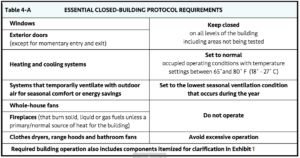Radon Testing, at a glance.
Your Real Estate Agent or Home Inspector may be suggesting that you do a “Radon Test” before you move into your new home. What is Radon and how is it tested?
Here are some quick facts to grasp the concept and links to more information.
What is Radon
- Radon is a radioactive element that is toxic, colorless and odorless.
- Radon is in nearly all soil types and gets into a home through gaps/cracks in the home and foundations. Basements usually have the highest concentrations of Radon.
- Radon is the leading cause of lung cancer among non-smokers, and second among smokers. Read more here.
- On average, indoor Radon levels in Douglas County (Colorado) are approximately 50% higher than the recommended “Action Level” set by the U.S. EPA.
How do we test for Radon?
During a typical home sale, we do a “short-term test” that is roughly 60 hours in total. This means that a test device is strategically placed in the home 60hr radon test begins. The 60 hour test consists of a 12 hour delay, followed by 48 hours of recorded testing. After the test is complete, a report is generated that shows the average radon levels in the home during that time.
Other notes to consider:
The test must completed in “Closed Home Conditions” (See the graphic below). This means keeping all windows and doors closed except for normal entry and exit, and not operating fans or other machines (Swamp coolers, whole house fans etc.) which bring in air from the outside . Fans that are part of a radon-mitigation system or small exhaust fans operating for only short periods of time may run during the test. Closed Home Conditions must be maintained 12 hours prior to the test, and for the duration of the 48 hour test. Our monitors include features that detect tampering of the conditions of the home, or of the monitors themselves.

The home will need to be accessed twice for approximately 10 minutes. Once to drop the monitor, and once to pick it up at least 60 hours later. If there is a home inspection scheduled with the radon testing, the monitor may be dropped off prior to the inspection so the results can be read at the time of inspection. Another option is to drop the monitor off during the inspection, and returning at least 60 hours later to gather the monitor and receive the report.
The EPA recommends taking action to mitigate Radon if the results of the test are 4.0 pCi/L or greater. (That’s Picocuries per liter, and I’m not going to define that here! It’s the number 4.0 that is important). The average indoor Radon level in the U.S. is 1.3 pCi/L. There is no “safe level” of Radon established by the EPA. It is up to the buyer or homeowner to take action or not.
Although a 48 hour test is typical for a home sale, long-term testing is more accurate. Long term testing will take at least 90 days, and usually isn’t possible during the diligence period of a home sale. If the initial test comes back high we recommend testing again, preferably for a longer duration. If there isn’t time for that, a Radon Mitigation system can be installed and another test can be completed later to verify the system is working as intended. Radon Mitigation systems typically cost $1500 to $2500, depending on the specific home construction, location and installation techniques.
Order a Radon Test HERE.
Colorado Radon Testing Laws. HERE (Effective July 2022)
Read more about Radon HERE.




Those who experience severe summers especially with increased muggy air, and the scorching sun would know the importance of investing in the ideal kind of cooling appliance. Depending on your budget, needs, climatic conditions, you might come to realize that not all methods of cooling are suitable for every environment.
Good point. You’re right!
Perfect! A radon test is carried out by placing two small detectors, each about the size of an air freshener, in your home for three months. One detector is placed in a bedroom, and the other in a living room— the places most occupied by the family.
Welp, not sure where these blog comments come from but that is 100% not true.
It provides clear information that empowers readers to make informed decisions about radon testing and mitigation.
This is a helpful resource for understanding radon risks and the importance of testing in maintaining a safe home environment.